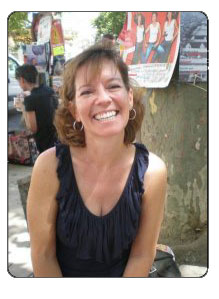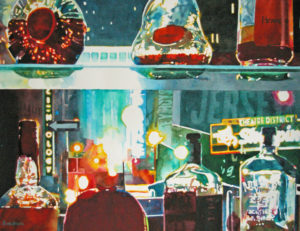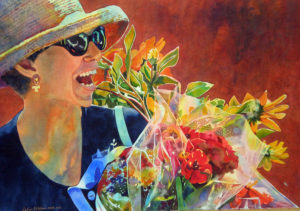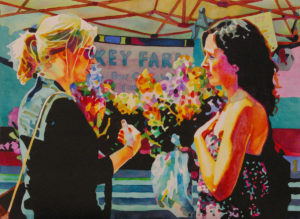 I first met Palm Desert watercolorist Robin St. Louis about fifteen years ago when I had attended a meeting of the Coachella Valley Watercolor Society. I was new to the desert group and sat shyly in the rear, watching various members showcase their current projects. In attendance were both dedicated artists and hobbyists, but one could not get through that session without remembering the work of Robin St. Louis.
I first met Palm Desert watercolorist Robin St. Louis about fifteen years ago when I had attended a meeting of the Coachella Valley Watercolor Society. I was new to the desert group and sat shyly in the rear, watching various members showcase their current projects. In attendance were both dedicated artists and hobbyists, but one could not get through that session without remembering the work of Robin St. Louis.
That evening she propped her art up on an easel, her talent undeniable, and I wondered how her artistic life would unfold. It was with that memory in mind that these many years later, I wanted to catch up with Robin to discuss her creative life since that first artful meeting.
Robin: No, actually, I studied philosophy. As a young child I loved to draw but I didn’t realize I wanted to be an artist until much later. I took a different path. I was a decent writer and eventually did grant writing for non-profits for a few years after college.
Robin: Well, we lived in Santa Barbara when the kids were young, and I took my first watercolor class there, once a week. I had never taken a serious art class before and I truly loved it. It gave me a little break from my toddler, Andy (laughs), who went to childcare for a few hours and it allowed me to carve out time for myself, time to paint. It really was wonderful! I would paint mostly in class and try to find time at home, but finding time was often hard with the children. Several years later we moved from Santa Barbara to the desert and I made the decision then to paint seriously.
Robin: I became a portrait painter, on commission. I painted mostly children, with a goal of one portrait a month. I was very busy and in time I had a four-year waiting list.
Robin: Yes, I generally painted children that I knew, (neighbors or friends children), and I would use photographs for reference. You need more than the information from the photograph to tell the story…it helps to know the personality of the subject.
Robin: Yes, definitely. Artistically things were evolving. My biggest epiphany in terms of professionalism came during those “Oprah” years when there was a great deal of media attention regarding the idea of incorporating gratitude into one’s life. I started making a list of things I was grateful for and painting was on the top of the list. Prior to that, painting was something I did after all my other “to-dos” were accomplished; I thought of it as the cherry on top. I decided to reorganize my day and painting became number #1 on my to-do list. I likened it to the story of the mason jar… If you had a jar and several good size rocks and some smaller rocks and sand, and you had to get all of them in the jar, which of those things would you put in first? You would put in the big stuff first and fill in the rest. I realized that the big stuff was my painting and it became my daily priority.
Robin: Every day I would get an index card and write down the necessary things to accomplish that day. I figured out how long each of those must-do things would take, perhaps 1 ½ hours, and then I would paint until about 1 ½ hours before it was time to pick up the kids from school. I would get those chores done, pick up the children, take them to after school activities and then dinner. There was little personal time left after that so I felt fortunate that I had allowed myself time each day to paint. I found that painting everyday gave me confidence and I kept plugging along. Reorganizing my day gave me a clear mind and I found I could paint freely without chores hanging over my head.
Robin: I had been painting portraits for about fifteen years and there were times when working on a commission I felt as if there was someone looking over my shoulder; the need to please the client. I wanted a more freeing experience, so I began to paint different things, different subject matter and it became a wonderful addition to my portrait work. Eventually this led me to entering competitions, exhibitions and so forth.

"Dinner Plans," 2018

"Times Square Nightcap," 2017

"All She Needs, #10" 2009

"Marketing Majors," 2013

"Heart to Heart," 2013
Robin’s watercolors are luminous and at the same time bold in their brilliance of color. While her technique may seem controlled the result feels free and loose. Her transparent washes allow the light to reflect off the surface of the paper through layers of rich colors that seem to glow. She paints varied subjects, florals and still life’s, but her subjects of people, particularly of women in their daily life, conversing, laughing, choosing fruit from the market and holding flowers are some of my favorites.
Robin: Normally I work from photographs that I take on vacations or many from my visits at the farmers market in Santa Barbara. I love the light there, the flowers, the fruit, plus the people are engaged so they don’t know I’m taking their picture. I paint on Winsor & Newton 140 lb. hot press watercolor paper, usually 22″x30” or I enjoy working on 30″x40” paper. I soak the paper in cold water first and stretch it and staple it which prevents it from buckling. After I allow it to dry, I take a sponge and rewet the paper randomly, so some areas remain dry which adds to the look of the finished painting. Then I take large brushes and loosely splatter or brush the underpainting wash using four colors; a yellow called New Gamboge and then doing the same with a Permanent Rose or Winsor Red and then two blues, a Peacock Blue and a French Ultramarine Blue; without trying to place the colors in any specific way.
Robin: I don’t draw directly on the paper instead I draw on tracing paper and transfer the drawing to the watercolor paper. There are a couple of reasons for this. First, I don’t want the drawing to steer my painting in any predetermined color direction in the first layer; I prefer things to just be a surprise. Second, I would rather make my drawing mistakes happen on the tracing paper, eliminating erasure marks or tears on the paper. I use homemade graphite carbon paper to transfer my drawings which are very detailed and because all the drawing decisions are done early, in an odd way it frees me up during the painting process.
Robin: I would say three weeks, usually painting every day, 6 days a week with one day off. I generally paint about four hours a day in the afternoon because it’s the best time of my day. When the cats wake up from them afternoon nap, it’s time for me to quit.
Robin: Yes, this was my son’s room. The two biggest splurges were a flooring with a polymer coating that protects it from paint spills and we put in a commercial restaurant sink. My lucky husband doesn’t need to buy me jewelry as I’m happy with this sink, it is my pride and joy!
Robin: I don’t know really. I have a great sense of excitement just painting every day and I look forward to trying new things.
Robin: I like teaching because it combines many of the things that I enjoy. I enjoy public speaking and I am highly organized. I can put lessons together that make logical sense and the process of planning reconnects me to the pleasure painting. I enjoy showing students tools they can use to plan their paintings so that they have stronger compositions. Having a road map also helps them paint more confidently. Seeing the students joy in being able to paint for three days and realizing what they had to do to get that time out from their other responsibilities is also invigorating. At the same time, I am not sure how many workshops I would want to do. It is very time consuming with the prep, the lesson plans, and traveling; it all takes away from my painting time. For the moment I am happy planning one workshop a year. I was recently asked if I would like to teach a Masterclass in the Netherlands. Certainly, I would love to do that!
Robin: The artist, Skip Lawrence says, “Any pleasure you hope to get from painting you should get in the studio” but it is fun to see your painting on the wall and to receive an award. The most fun for me is that I know a lot of other artists from these shows and through volunteering on boards of art organizations. I enjoy being a part of this art community and visiting people who are interested in the same things I’m interested in.
Robin: Yes, but its a scary thought. When I have been away from painting for a time or when I have been on vacation…I realize I need to get back into my painting routine if I’ve been away. It’s very easy to lose momentum and, also confidence in my painting if I’m away from it for any period. In then gets harder and harder to go back to the studio. I can see how a person could drift away. But life is so much more fulfilling with daily painting in it.
I asked Robin if there was anything she would like to add to our interview, anything I may have forgotten. Her first thought was perhaps we should revisit her techniques on her watercolor process, so I strongly suggest you visit her website at www.robinstlouis.com for a step-by-step demonstration of her watercolor process.
Robin’s exceptional watercolors speak for themselves. Her expertise in handling the medium makes her a great teacher and at the same time, she continues to learn and welcomes new challenges. There are new painting surfaces she hopes to experiment with and there are new technical challenges waiting for her to explore. It is obvious that Robin’s artistic life continues to unfold. As we closed our interview it seemed quite appropriate that her cats came to the studio door, purring in unison; it’s their naptime and our session is over for today. Please enjoy viewing Robin’s website and the images attached.
To view more of Robin St. Louis's art or to view a schedule of upcoming workshops, please visit her website: www.robinstlouis.com

Very proud to have three of Robin’s paintings hanging in our home. They are the first things we share with new visitors. Personally knowing the artist is a wonderful joy.
How wonderful! She is a very talented watercolorist and lovely person. Thank you for the comment.